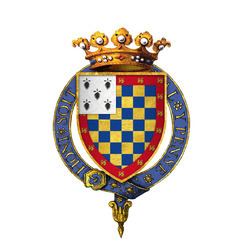Reign 1345–1399 Name John Duke | Successor John V | |
 | ||
Spouse Mary PlantagenetLady Joan HollandJoanna of Navarre | ||
John IV, Duke of Brittany
John IV the Conqueror KG (in Breton Yann IV, in French Jean IV, and traditionally in English sources both John of Montfort and John V) (1339 – 1 November 1399) was Duke of Brittany and Count of Montfort from 1345 until his death and 7th Earl of Richmond from 1372 until his death.
Contents
- John IV Duke of Brittany
- Numbering
- Conquest
- Power struggles
- Clisson affair
- English Knighthood
- Marriages
- Children
- References

Numbering
He was the son of John of Montfort and Joanna of Flanders. His father claimed the title Duke of Brittany, but was largely unable to enforce his claim for more than a brief period. Because his father's claim to the title was disputed, the subject of this article has often been numbered John (IV), while his father has been referred to as simply "John of Montfort" (Jean de Montfort). English historians number him as John V, since the English king recognized his father's title. In France he is commonly known as John IV, since the French monarchy, unlike the English, never acknowledged his father's title.
Conquest
The first part of his rule was tainted by the Breton War of Succession, fought by his father against his cousin Joanna of Penthièvre and her husband Charles of Blois. With French military support Charles was able to control most of Brittany. After his father's death, John's mother Joanne attempted to continue the war in the name of her baby son. She became known as "Jeanne la Flamme" (Fiery Joanna) for her fiery personality. However, she was eventually forced to retreat with her son to England to ask for the aid of Edward III. She was later declared insane and imprisoned in Tickhill Castle in 1343. John and his sister Joan of Brittany were taken into the King's household afterwards.
John returned to Brittany to enforce his claim, with English help. In 1364, John managed to win a decisive victory against the House of Blois in the Battle of Auray, with the support of the English army led by John Chandos. His rival Charles was killed in the battle and Charles's widow Joanna was forced to sign the Treaty Guérande on 12 April 1365. In the terms of the treaty, Joanna gave up her rights to Brittany and recognized John as sole master of the duchy.
Power struggles
Having achieved victory with English support (and having married into the English royal family), John was constrained to confirm several English barons in positions of power within Brittany, especially as controllers of strategically important strongholds in the environs of the port of Brest, which gave the English military access to the peninsula and which took revenue from Brittany to the English crown. This English powerbase in Brittany was resented by the Breton aristocrats and the French monarchy, as was John's use of English advisers. However, John V declared himself a vassal to king Charles V of France, not to Edward III of England. This gesture did not placate his critics, who saw the presence of rogue English troops and lords as destabilizing. Faced with the defiance of the Breton nobility, John was unable to muster military support against Charles V, who took the opportunity to exert pressure over Brittany. Without local support, in 1373 John was forced into exile once more in England.
However, Charles V made the mistake of attempting to completely annex the duchy to France. Bertrand de Guesclin was sent to make the duchy submit to the French king by force of arms in 1378. The barons revolted against the annexation and invited John V back from exile in 1379. He landed in Dinard and took control of the duchy once more with the support of local barons. An English army under Thomas of Woodstock, 1st Duke of Gloucester was landed at Calais and marched towards Nantes to take control of the city. However, John reconciled with the new French king Charles VI and paid off the English troops to avoid a confrontation. He ruled his duchy thereafter in peace with the French and English crowns for over a decade, maintaining contact with both, but minimising open links to England. He also managed to extricate Brest from English control in 1397 using diplomatic pressure and financial inducements.
Clisson affair
In 1392 an attempt was made to kill Olivier de Clisson, the Constable of France, who was an old enemy of the duke's. The attacker, Pierre de Craon, fled to Brittany. John was assumed to be behind the plot, and Charles VI took the opportunity to attack Brittany once more. Accompanied by the Constable, he marched on Brittany, but before he reached the duchy the king was seized with madness. Relatives of Charles VI blamed Clisson, and instituted legal proceedings against him to undermine his political position. Stripped of his status as Constable, Clisson now took refuge in Brittany himself, and was reconciled with John (1397), becoming a close adviser to the duke.
English Knighthood
John V was knighted by Edward III in 1375–1376 as a member of the Order of the Garter. He is believed to be the only Duke of Brittany to have attained this English honour.
Marriages
John V married three times:
1) Mary Plantagenet (1344–1362), daughter of King Edward III of England and Philippa of Hainault.2) Joan Holland (1350–1384), daughter of Thomas Holland, 1st Earl of Kent, in London in May 1366.3) Joanna of Navarre (1370–1437), daughter of King Charles II of Navarre, at Saillé-près-Guérande, near Nantes on 2 October 1386.Joanna was the mother of all of John V's children. After his death she served as Regent to their son John VI and eventually married Henry IV of England.
